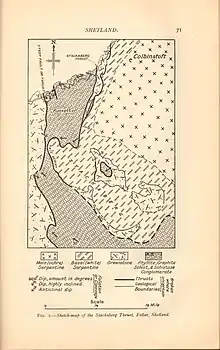James Phemister
Dr James Phemister FRSE FGS FMS (3 April 1893 – 18 May 1986) was a 20th-century Scottish geologist.
Life
He was born in Govan on 3 April 1893, the son of John Clark Phemister (b.1858) and his wife, Elizabeth Galbraith Crawford. He was the older brother to Thomas Phemister.
He studied mathematics, natural philosophy and geology at Glasgow University graduating MA BSc in 1915.[1] His career was interrupted by the First World War during which he served in the Royal Garrison Artillery. He was severely wounded in 1917.[2][3]

In 1921 he joined the British Geological Survey as a Geologist, mainly working in the Scottish Highlands.
Between 1926 and 1929 he worked in Persia with W. F. P. McLintock, pioneering the use of the gravity torsion balance in oil exploration.[3][5]
In 1931 he was elected a Fellow of the Royal Society of Edinburgh. His proposers were Murray Macgregor, Sir John Smith Flett, W. F. P. McLintock and Herbert Harold Read. He won the Society's Neill Prize for the period 1959–61.[6]
In 1935 he moved to London as official Petrograher to HM Geological Survey.
In the Second World War he served with the government's Chemist Department, his roles including geological analysis of ballast within the V-1 flying bomb to assess where it might have been launched.[7]
In 1946 he became Assistant Director to HM Geological Survey but gave up the post in 1953 in order to return to Edinburgh, working in the Grange Terrace office with Dr Walter Mykura.
He died in Edinburgh on 18 May 1986.
Family
He was married to Margaret Clark (d.1982). They had two sons and a daughter.
Publications
- Phemister, James (1936). Scotland: The Northern Highlands (Report). British Regional Geology. Edinburgh: HMSO. The full text of the Third Edition of this work (1960) is available at "Archive.org".
- Mykura, Walter; Phemister, James; Sabine, Peter Aubrey (1976). The geology of Western Shetland: (explanation of One-inch Geological Sheet Western Shetland, comprising Sheet 127 and parts of 125, 126 and 128). Edinburgh: HMSO.
- MacGregor, Malcolm; Phemister, James (1979). Geological Excursion Guide to the Assynt District of Sutherland. Edinburgh: Edinburgh Geological Society.
References
- "Biography of James Phemister". The University of Glasgow Story. Retrieved 24 July 2018.
- "James Phemister – Obituary" (PDF). Proceedings of the Geological Society of Glasgow for Sessions 129–132 (1986–1990), pages 32–34. Retrieved 24 July 2018.
- Howie, R.A. (1987). "Memorial of James Phemister 1893–1986" (PDF). American Mineralogist. 127: 1275–1276.
- Summary of progress of the geological survey of Great Britain for 1930, Part 1 (Report). London: HMSO. 1931.
- McLintock, W.F.P.; Phemister, J. (1929). "The use of the torsion balance in the investigation of geological structure". Trans. Inst. Min. & Metall. 38: 209–303.
- Biographical Index of Former Fellows of the Royal Society of Edinburgh 1783–2002 (PDF). The Royal Society of Edinburgh. July 2006. ISBN 0 902 198 84 X. Archived from the original (PDF) on 4 March 2016. Retrieved 18 December 2017.
- Ransted, Chris (2013). Disarming Hitlers V Weapons. Pen & Sword Military. ISBN 9781781593868.